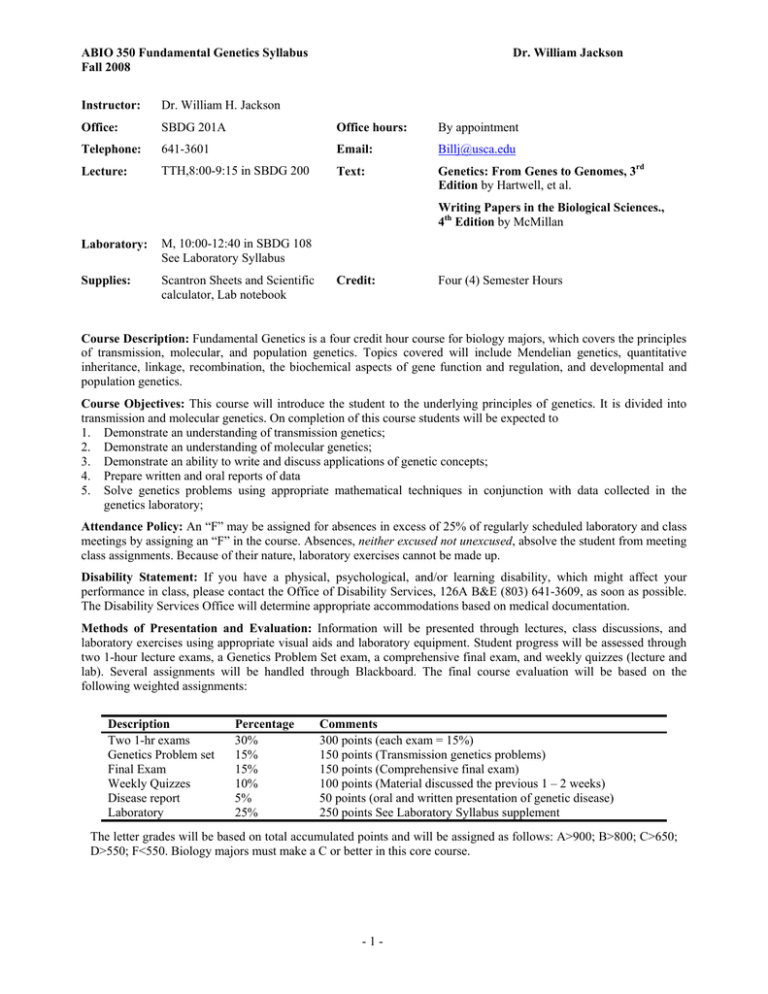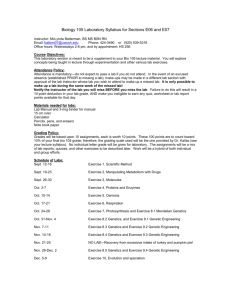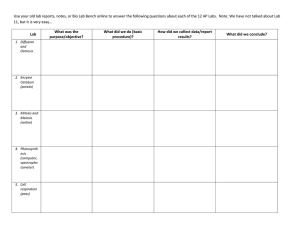ABIO 350 Fundamental Genetics Syllabus Dr. William Jackson Fall 2008
advertisement

ABIO 350 Fundamental Genetics Syllabus Fall 2008 Dr. William Jackson Instructor: Dr. William H. Jackson Office: SBDG 201A Office hours: By appointment Telephone: 641-3601 Email: Billj@usca.edu Lecture: TTH,8:00-9:15 in SBDG 200 Text: Genetics: From Genes to Genomes, 3rd Edition by Hartwell, et al. Writing Papers in the Biological Sciences., 4th Edition by McMillan Laboratory: M, 10:00-12:40 in SBDG 108 See Laboratory Syllabus Supplies: Scantron Sheets and Scientific calculator, Lab notebook Credit: Four (4) Semester Hours Course Description: Fundamental Genetics is a four credit hour course for biology majors, which covers the principles of transmission, molecular, and population genetics. Topics covered will include Mendelian genetics, quantitative inheritance, linkage, recombination, the biochemical aspects of gene function and regulation, and developmental and population genetics. Course Objectives: This course will introduce the student to the underlying principles of genetics. It is divided into transmission and molecular genetics. On completion of this course students will be expected to 1. Demonstrate an understanding of transmission genetics; 2. Demonstrate an understanding of molecular genetics; 3. Demonstrate an ability to write and discuss applications of genetic concepts; 4. Prepare written and oral reports of data 5. Solve genetics problems using appropriate mathematical techniques in conjunction with data collected in the genetics laboratory; Attendance Policy: An “F” may be assigned for absences in excess of 25% of regularly scheduled laboratory and class meetings by assigning an “F” in the course. Absences, neither excused not unexcused, absolve the student from meeting class assignments. Because of their nature, laboratory exercises cannot be made up. Disability Statement: If you have a physical, psychological, and/or learning disability, which might affect your performance in class, please contact the Office of Disability Services, 126A B&E (803) 641-3609, as soon as possible. The Disability Services Office will determine appropriate accommodations based on medical documentation. Methods of Presentation and Evaluation: Information will be presented through lectures, class discussions, and laboratory exercises using appropriate visual aids and laboratory equipment. Student progress will be assessed through two 1-hour lecture exams, a Genetics Problem Set exam, a comprehensive final exam, and weekly quizzes (lecture and lab). Several assignments will be handled through Blackboard. The final course evaluation will be based on the following weighted assignments: Description Two 1-hr exams Genetics Problem set Final Exam Weekly Quizzes Disease report Laboratory Percentage 30% 15% 15% 10% 5% 25% Comments 300 points (each exam = 15%) 150 points (Transmission genetics problems) 150 points (Comprehensive final exam) 100 points (Material discussed the previous 1 – 2 weeks) 50 points (oral and written presentation of genetic disease) 250 points See Laboratory Syllabus supplement The letter grades will be based on total accumulated points and will be assigned as follows: A>900; B>800; C>650; D>550; F<550. Biology majors must make a C or better in this core course. -1- ABIO 350 Fundamental Genetics Syllabus Fall 2009 Dr. William Jackson TENTATIVE LECTURE SCHEDULE Date Aug 20 Aug 25 Aug 27 Sep 1 Sep 3 Sep 8 Sep 10 Sep 15 Sep 17 Sep 22 Sep 24 Sep 29 Oct 1 Oct 6 Oct 8 Oct 13 Oct 15 Oct 20 Oct 22 Oct 27 Oct 29 Nov 3 Nov 5 Nov 10 Nov 12 Nov 17 Nov 19 Nov 24 Nov 26 Dec 1 Dec 3 Dec 10 Week 1 2 Topic/Comments Chapter 2 3 3 3 3 Mendel’s Breakthrough Mendel’s Breakthrough Extensions to Mendel Extensions to Mendel 4 The Chromosomal Theory of Inheritance 4 5 Linkage and Mapping 5 6 Linkage and Mapping Exam I DNA: Recombination and Replication DNA: Recombination and Replication DNA: Recombination and Replication Fall Break DNA: Recombination and Replication 5 2-5 6 6 6 11 DNA: Recombination and Replication Gene Structure and Function Gene Structure and Function 6 7 7 12 Gene Structure and Function 7 13 Gene Expression Exam II Gene Expression 7 8 9 10 14 15 16 6 8 6-7 8 Gene Expression Thanksgiving Holiday (Nov 21 – 23) Biotechnology 8 8 Final Exam at 8:00 AM in SBDG 200 2-8 You will be expected to endorse the USCA HONOR PLEDGE on every assignment: 'On my honor as a University of South Carolina Aiken student, I have neither given nor received any unauthorized aid on this assignment/examination. To the best of my knowledge, I am not in violation of academic honesty' Genetics Laboratory: Genetics Laboratory is not separate from Genetics Lecture; therefore, students are expected to synthesize the material covered in lecture, laboratory, and the text. Each student is expected to meet every laboratory session, as it is impossible to recreate the laboratory setup after the scheduled meeting time. In general, each laboratory meeting will be divided into three sessions and designed to (1) extending lecture, (2) practice genetics problems, and (3) carry out assigned laboratory exercises. Several laboratory meetings will be required to work on genetic crosses between mutant strains of Drosophila melanogaster and will require several weeks to complete. Because the laboratory studies involve living systems, the student must be prepared to work on the project when the need arises. While some of the work can be done during normal laboratory meeting times, this is not always the case. Genetics problems will be introduced via Blackboard quizzes that will be available the week prior to each lab meeting. Students are required to complete each quiz prior to the lab meeting. Online quizzes serve as practice and review for in-class quizzes and exams. In-class quizzes will be administered at the beginning of each lab meeting and will be similar to the preceding online quiz. In addition the Genetics Problem Set will include problems similar to the online and in-class quizzes. A second major component of genetics laboratory is a research project on a specific genetic disease. Students will carry out a literature search and write a one-page summary that -2- ABIO 350 Fundamental Genetics Syllabus Fall 2009 Dr. William Jackson includes at least three references from peer-reviewed journals and/or medical textbooks. References must be cited using CSE format (Chapter 4 in the supplemental text). Students will also give a 10-minute oral presentation of their topic during the scheduled laboratory periods on Nov 26 and Dec 3. PowerPoint is required for these presentations. Students are strongly cautioned to be on their guard against plagiarism when preparing all reports. All reports must be submitted in hardcopy and electronic formats. The electronic copy will be monitored for plagiarism. Grading: The laboratory component of ABIO 350 is worth 25% (250 points) of the final course grade and will be based on both written and oral reports. The due dates and total points for each assignment are shown in the table below: Description Probability/hypothesis testing report Sample data set report Drosophila cross one report Drosophila cross two report Drosophila cross three report Drosophila cross four report Lab quizzes Laboratory participation TOTAL Due Date Sep 14 Sep 21 Oct 19 Oct 2 Nov 9 Nov 16 Points 5 5 40 40 40 40 50 30 250 TENTATIVE LABORATORY SCHEDULE Date Aug 24 Meeting 1 Aug 31 2 Sep 14 3 Sep 21 Sep 28 Oct 5 Oct 12 Oct 19 Oct 26 Nov 2 Nov 9 4 5 6 7 8 9 10 Nov 16 11 Nov 23 Nov 30 12 13 Exercise Introduction to genetics lab (syllabus); Group organization Probability and Hypothesis Testing Introduction to genetics research – Writing a Lab Report Introduction to Drosophila melanogaster Introduction to Drosophila melanogaster Monohybrid cross; Sample Data Set Monohybrid and Dihybrid Cross Monohybrid and Dihybrid Cross Sex Linkage Cross Sex Linkage Linkage cross Linkage maps PROBLEM SET EXAM Introduction to research (library); Topic assignments Drosophila cross write ups due Problem set review Research Oral presentations of research topics Oral presentations of research topics Source Coin Toss Chapter 4 Handout Chapter 4 Handout Handout Chapter 6 Chapter 10 Handout Handout Laboratory Reports. Written laboratory reports will be required for several exercises (see above). All reports are required to be one-page in length and follow the following criteria: double-spaced with 1-inch margins and 11 point Times New Roman font. Each report will be written in the form of a scientific paper and include the following: Title, Introduction, Methods, Results, and Discussion. A more complete discussion of how to write laboratory report can be found in chapter 4 of your supplemental text: Writing Papers in the Biological Sciences, 4th Edition by McMillan. Specific requirements for writing laboratory reports for Genetics can be found on the Genetics Blackboard site. -3-








